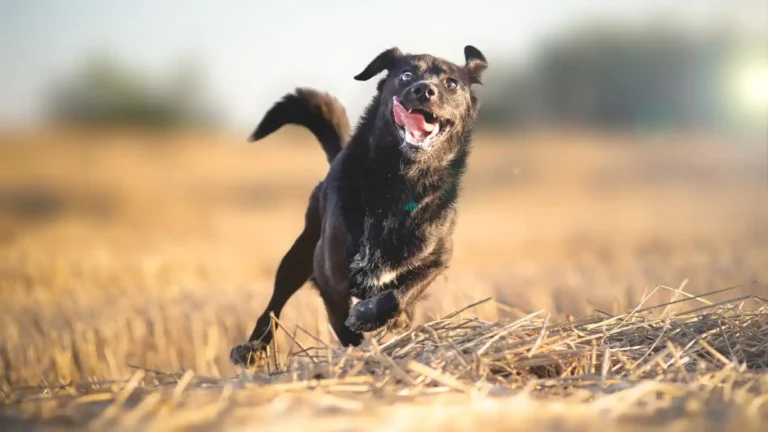Ultimate Guide to Feed Your Dog for Better Endurance and Stamina
As an Animal Care Specialist with years of experience caring for pets in shelters and clinics, I’ve had the privilege of helping countless dogs maintain their health and fitness. A question that often comes up from pet parents is, “How can I feed my dog for better endurance and stamina?” The answer isn’t as straightforward as simply choosing the right brand of kibble. In fact, the right diet for your dog depends on their age, breed, health status, and activity level. But don’t worry, I’m here to share some of the best practices I’ve learned, along with practical tips you can use to ensure your dog is as strong, energetic, and healthy as possible!
Understanding Your Dog’s Nutritional Needs for Endurance

To feed a dog for better endurance and stamina, the first thing you need to understand is what goes into their diet. Dogs, much like humans, require a balance of proteins, fats, carbohydrates, vitamins, and minerals to maintain their energy levels and overall health. But what does that balance look like, and how can it help your dog’s stamina?
The main fuel for your dog’s body comes from protein and fats. These macronutrients help build muscle, provide long-lasting energy, and support tissue repair after exercise. If you have an active dog—whether they’re a working breed, a high-energy companion, or just love to run around at the park—you’ll need to ensure that their diet is rich in the right kinds of proteins and fats. Additionally, keeping your dog hydrated is just as important, as dehydration can lead to fatigue and hinder their ability to perform at their best.
Protein: The Building Block of Stamina
When you think of muscle and strength, think protein! Protein is essential for the development and repair of muscles, tissues, and organs in your dog’s body. If you want your dog to have better endurance, ensuring they get high-quality protein is non-negotiable.
- Chicken, turkey, and beef are great sources of animal-based protein that are highly digestible and beneficial for active dogs.
- Fish, like salmon and tuna, not only provides protein but is also rich in omega-3 fatty acids, which help reduce inflammation and promote joint health—important for endurance.
- Eggs are another excellent protein source and contain all the essential amino acids necessary for muscle repair.
Ideally, look for dog food that lists a high-quality protein as the first ingredient, like chicken or lamb, rather than something vague like “meat meal” or “by-products.” I’ve learned from my years of experience that knowing exactly what’s in your dog’s food can make a huge difference in their performance and energy levels.
Fats: The Fuel Your Dog Needs for Energy
Just like us, dogs need healthy fats in their diet to keep their energy levels high, especially if they’re active. Fats are more energy-dense than protein or carbohydrates, meaning they provide long-lasting energy for endurance. Not only that, but fats also help keep your dog’s coat shiny and skin healthy, supporting their overall well-being.
- Fish oils are packed with omega-3 and omega-6 fatty acids that are beneficial for inflammation control, heart health, and skin condition.
- Chicken fat is a great source of energy and helps promote healthy digestion.
- Coconut oil is another fat source that can enhance your dog’s endurance by improving energy levels and aiding in the absorption of essential nutrients.
Many commercial dog foods include animal fats like chicken fat or beef tallow, which are essential for active dogs. However, it’s always worth checking that the fat content comes from quality, digestible sources. Excess fat or poor-quality fat sources can lead to weight gain and reduced stamina over time, so balance is key.
The Importance of Carbohydrates and Fiber

While protein and fats are the primary nutrients for building endurance and muscle, carbohydrates are also important for providing quick energy during physical activity. Unlike proteins and fats, which take longer for the body to break down, carbohydrates are quickly digested and used as fuel for your dog’s muscles. If your dog is doing short bursts of exercise, carbohydrates can be incredibly beneficial for a quick energy boost.
That said, not all carbs are created equal. Whole grains like brown rice, sweet potatoes, and quinoa are fantastic sources of energy because they are packed with nutrients and fiber, which supports digestion and helps regulate blood sugar. Fiber, especially, is essential for maintaining healthy gut function, ensuring your dog’s body can process all those nutrients properly and efficiently.
What Carbs to Look for in Dog Food
When looking for carbs in your dog’s food, focus on high-quality, easily digestible sources. Some of my personal favorites are:
- Sweet potatoes: They’re full of fiber and are easier on the digestive system than other starchy foods.
- Brown rice: This is a great source of slow-release energy, making it perfect for dogs that need endurance throughout the day.
- Oats: These are gentle on the stomach and provide a steady energy supply, without causing spikes in blood sugar.
However, you’ll want to steer clear of refined carbohydrates like corn or wheat, which offer little nutritional value and can cause energy crashes. A well-balanced diet with the right mix of healthy fats, proteins, and carbs will help your dog stay energized throughout the day and excel during exercise.
Hydration: The Often Overlooked Key to Stamina

Finally, let’s talk about something that’s often overlooked: hydration. Without proper hydration, your dog’s endurance will be compromised. Dehydration can lead to fatigue, muscle cramps, and slower recovery times after exercise. Make sure your dog has access to fresh water at all times, especially if they’re engaging in strenuous activity.
For highly active dogs, consider adding wet food to their diet, as it can help increase their fluid intake. Another trick I learned over the years is offering ice cubes or ice chips during playtime—this is not only fun for dogs but helps them stay hydrated as well!
Now that we’ve covered the basics of what your dog needs for better stamina and endurance, the next step is finding the right food and feeding schedule. Stick around for more tips on how to optimize your dog’s diet for long-lasting energy!
Feeding Schedules and Portions: How to Optimize Your Dog’s Diet for Endurance

Now that we’ve covered the types of nutrients your dog needs for optimal endurance and stamina, let’s dive into the practical side of feeding: schedules and portion sizes. Feeding your dog the right food is only part of the equation. How and when you feed them can make a huge difference in their energy levels, especially if your dog is particularly active or engaged in high-intensity exercise.
One thing I’ve learned in my years of working with dogs is that timing and portion control are just as important as the food itself. Overfeeding can lead to weight gain and sluggishness, while underfeeding can leave your dog feeling lethargic and weak. Striking the right balance is key, and that starts with understanding how much food your dog actually needs based on their size, activity level, and metabolism.
When to Feed Your Dog for Maximum Energy
For active dogs, feeding schedules can play a huge role in maintaining their energy levels throughout the day. If you’ve got a dog that runs with you on morning jogs or goes on long walks, their food intake timing will affect their stamina and performance.
- Pre-exercise meal: I recommend feeding your dog about 1.5 to 2 hours before engaging in any intense physical activity. This allows the body to digest and absorb the nutrients without feeling weighed down.
- Post-exercise meal: After a workout or a long run, your dog’s muscles will need time to recover, so it’s important to feed them a meal that’s rich in protein and carbs. This helps replenish their energy stores and promote muscle repair.
For dogs who aren’t doing high-intensity activities, feeding once or twice a day should suffice. However, for more active dogs or working breeds, splitting their meals into two or three smaller portions throughout the day can help maintain steady energy levels and prevent crashes.
Portion Control: Finding the Right Balance
Portion control is one of the most vital aspects of managing your dog’s endurance. Overfeeding can lead to unnecessary weight gain, which can hinder your dog’s performance and cause joint strain, especially for active breeds. On the flip side, feeding too little can lead to fatigue and muscle breakdown.
As a general rule of thumb, the more active your dog is, the more calories they’ll need. If you have a high-energy dog, such as a Border Collie or a Labrador, you’ll need to adjust their portions accordingly. A good way to determine your dog’s needs is to start with the recommendations on the dog food packaging and adjust based on your dog’s weight and activity level. You may also want to consult your vet for a more tailored feeding plan.
Personally, I’ve found that monitoring my dogs’ weight, adjusting meals as needed, and keeping track of their energy levels and performance gives me the best insight into how much food they need. It’s all about finding that sweet spot for each individual dog!
Supplements to Boost Your Dog’s Endurance

In addition to providing high-quality food, there are certain supplements that can help enhance your dog’s stamina and overall performance. Not all dogs will need supplements, but if your dog is engaged in intense activities or suffers from joint pain or inflammation, these can make a world of difference.
Glucosamine and Chondroitin for Joint Health
If your dog is highly active, especially in sports or long-distance activities, it’s important to look after their joints. Supplements like glucosamine and chondroitin can help support cartilage and improve joint function, which is especially useful for dogs who are prone to joint issues or arthritis as they age.
Glucosamine helps to rebuild cartilage, and chondroitin can reduce inflammation and improve flexibility. I’ve seen the positive impact these supplements can have on older dogs who still want to play and run around. Their joints feel more comfortable, and they have the stamina to keep going without being sidelined by discomfort.
Omega-3 Fatty Acids for Inflammation and Recovery
Omega-3 fatty acids are another supplement I highly recommend. These are excellent for reducing inflammation and promoting quicker recovery after physical exertion. Omega-3s, found in fish oil, help protect your dog’s muscles and joints and can give them the edge they need when it comes to endurance. These fatty acids also help improve coat quality and support cardiovascular health.
For dogs that participate in sports or high-energy activities, omega-3 supplements are a great addition to their diet. I’ve found that regular use of these can not only improve their stamina but also enhance their overall mood and mental clarity—something that’s often overlooked!
Antioxidants for Faster Recovery
After a long day of running or playing, your dog’s muscles will benefit from the healing power of antioxidants. These can help combat oxidative stress and reduce muscle fatigue, allowing your dog to bounce back faster and get back to their favorite activities with renewed energy.
Antioxidant-rich foods and supplements, such as blueberries and green tea extract, can aid in this recovery process. Including these in your dog’s diet can help improve overall stamina and endurance by ensuring that their muscles aren’t overloaded with free radicals after exercise.
Choosing the Right Dog Food for Endurance

When it comes to selecting the right food, there are countless options available on the market. It can be overwhelming to navigate all the brands and formulas. So, what should you look for when selecting food to help your dog maintain energy and stamina?
High-Quality, Animal-Based Protein
As we discussed earlier, animal-based proteins, like chicken, beef, or fish, are the most beneficial for active dogs. Look for dog food that lists these protein sources as the first ingredient. This is a key indicator that the food is designed to support muscle development and overall stamina. Avoid foods that rely on plant-based proteins, as these tend to be less digestible and less effective at supporting muscle repair.
Healthy Fats and Carbs
Also, make sure the food contains a balanced mix of healthy fats and complex carbohydrates. Look for ingredients like sweet potatoes, brown rice, and flaxseed that provide long-lasting energy. These ingredients will fuel your dog during high-energy activities and keep their body in top shape for endurance.
Don’t forget to consider your dog’s specific needs. Dogs with allergies, sensitivities, or unique health conditions might need specialized food. Consulting with a vet can help ensure you choose the best food based on your dog’s individual health and energy requirements.
So, now that you have the tools to feed your dog for better endurance and stamina, remember that every dog is unique. It’s all about finding the right combination of food, supplements, and schedules that work best for your furry friend. Stay tuned for more tips in the next part of this guide!
Exercise and Training for Building Endurance in Dogs

As we’ve covered so far, a well-balanced diet is crucial for boosting your dog’s stamina and endurance. However, nutrition alone isn’t enough. Regular exercise and training are key components of ensuring your dog remains fit, energetic, and ready for anything. Exercise helps your dog build muscle, strengthen their heart, and keep their joints healthy, all of which contribute to their overall endurance.
One thing I’ve learned over the years is that each dog is different. Just like people, some dogs have more energy than others, and their stamina levels vary. The key is finding a balance that works for your dog’s breed, age, and health condition. For example, a high-energy breed like a Border Collie may need more rigorous exercise than a more laid-back breed like a Bulldog. But no matter what, regular physical activity will help improve your dog’s stamina and keep them in peak condition.
Building Stamina with Regular Exercise
When it comes to exercise, it’s important to start slow and gradually increase intensity. This is especially true if you’re training a dog that isn’t used to high levels of activity. Here’s a basic approach to building your dog’s stamina:
- Start with daily walks: A brisk 20-30 minute walk is a great way to get started. This helps build endurance and allows your dog to get used to regular exercise.
- Introduce short bursts of activity: After a few weeks of walking, you can begin incorporating short sprints, fetch sessions, or playtime at the park. These high-intensity bursts help build stamina and strength.
- Gradually increase the duration and intensity: As your dog’s stamina improves, you can start increasing the duration of walks, runs, or playtime. Aim for a combination of longer, steadier activities and shorter, high-energy bursts to develop both endurance and explosive power.
It’s important to watch for signs of exhaustion in your dog. While they might love playing or running, overexertion can lead to injuries or fatigue. Be mindful of your dog’s behavior during and after exercise. A well-exercised dog should be tired but not overly fatigued, so keep an eye on their energy levels and adjust accordingly.
Training for Stamina and Mental Engagement
Physical exercise isn’t the only factor that impacts your dog’s endurance. Mental stimulation is just as important for building stamina. Active dogs, especially working breeds, benefit from both physical and mental challenges. Engaging their brains with tasks like obedience training, puzzle toys, or agility exercises can boost their endurance by keeping them sharp and focused.
Training sessions that incorporate both physical and mental elements will tire your dog out in the best way possible, improving their stamina without causing unnecessary stress on their body. Training doesn’t just keep them fit—it strengthens the bond you share with your pet, making the whole process more enjoyable for both of you!
Common Mistakes to Avoid When Feeding Your Dog for Endurance

While it’s easy to get excited about feeding your dog for better endurance, there are a few common mistakes that can trip you up. Over the years, I’ve seen many pet parents unknowingly hinder their dog’s stamina progress by making these simple errors. Let’s take a look at some of the most common mistakes and how to avoid them.
1. Overfeeding or Underfeeding
One of the biggest mistakes I see is overfeeding or underfeeding. As mentioned earlier, balance is key. Too many calories can lead to weight gain, sluggishness, and joint strain, while too few calories can leave your dog weak and lacking energy. Pay attention to your dog’s weight, and adjust their food portions based on their activity level.
It’s also important to remember that not all calories are created equal. While it’s easy to toss in some extra treats or “human food,” these often lack the nutritional quality needed for long-term energy and stamina. Stick with well-balanced, nutrient-rich food designed for your dog’s specific needs.
2. Ignoring Breed-Specific Dietary Needs
Different dog breeds have different nutritional needs. Working breeds, like German Shepherds or Belgian Malinois, may need higher protein levels and fats to support their activity, while toy breeds might require less. Make sure you’re choosing food that’s tailored to your dog’s breed and activity level. Just because a food is marketed as “high-energy” doesn’t mean it’s suitable for all dogs.
As an animal care specialist, I’ve seen the difference a tailored diet can make. For example, active breeds tend to benefit from more protein and fat, while senior dogs or smaller breeds may need lower-fat, higher-fiber food to support overall health. Make sure to do your research, or consult a vet to find the best diet for your dog’s needs.
3. Lack of Consistency
Consistency is another essential factor when it comes to feeding and exercising your dog for endurance. Dogs thrive on routine, so try to feed them at the same times each day and keep their exercise schedule predictable. A regular feeding schedule and consistent exercise plan will help your dog’s body adjust to the demands you’re placing on it, improving both endurance and overall health.
References
For further information on dog nutrition and endurance, check out these trusted resources:
Disclaimer
As always, it’s important to remember that every dog is unique, and what works for one dog might not work for another. This article provides general advice on feeding and exercise for better endurance and stamina, but it should not replace professional veterinary advice. Always consult with your veterinarian before making any significant changes to your dog’s diet or exercise routine, especially if your dog has any pre-existing health conditions or dietary needs.
By combining proper nutrition, exercise, and training, you’ll be giving your dog the best chance at a long, healthy life filled with boundless energy and stamina. Happy feeding, and here’s to many fun and active adventures with your furry friend!






